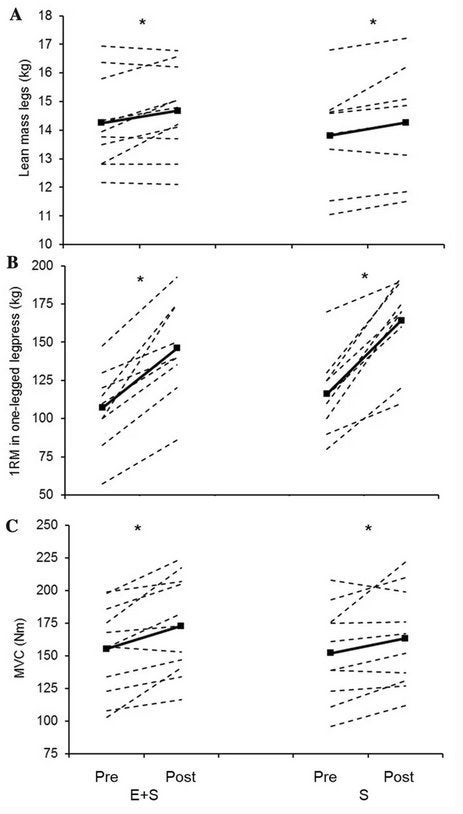In December 1992, I touched the rim of the basketball hoop in my high school gym. This was a momentous event: I’d never managed the feat before despite playing basketball all through high school and reaching my adult height a few years earlier. But the timing seemed odd: I’d been diagnosed with mononucleosis a few months before and as a result had been forced to stop exercising. I was the least fit I’d ever been.
It makes perfect sense in hindsight, though. Back in 1980, a researcher named Robert Hickson published a seminal paper on the “interference effect,” suggesting that heavy endurance training can block some of the gains of strength training. (For more background, check out this article I wrote in 2017.) Since then, there’s been tons of research trying to unravel why it happens and how to avoid it.
But the picture isn’t as clear as you might think. There have been lots of studies that �徱���’t find any interference effect, and no one is entirely sure which factors matter: the level of the athletes, the type and amount of endurance training, heavy versus light weights, and so on. For example, it mainly seems to be an issue if you’re doing at least four days a week of endurance training.
There’s also an unavoidable methodological challenge. If you compare a group doing just strength training or just endurance training with a group doing both, the latter group is either doing way more overall training than the other two groups, or less of each individual component. If, as some researchers suspect, caloric deficit is one of the drivers of the interference effect, that dilemma of how to match training loads is important. To determine the best way to develop overall fitness, it makes sense to constrain the total amount of training and vary how much strength versus endurance you do. But if what you really care about is racing fast, then you probably don’t want to subtract an endurance workout every time you add a strength workout.
With that in mind, in the European Journal of Applied Physiology, from a group in Norway led by Olav Vikmoen of the Inland Norway University of Applied Sciences, explores what happens when endurance athletes add strength to their usual routine. They compare the results of 11 weeks of twice-weekly heavy lower-body strength workouts in well-trained female duathletes (who compete in combined running and cycling races) with the same strength routine in untrained women. Crucially, both groups simply added the strength routine without changing the rest of their training (about five hours a week of running and cycling for the duathletes, and more or less nothing for the non-athletes). That makes it a good real-world test of what happens when you start strength training.
The strength routine involved four lower-body exercises: half-squats and ankle plantar flexions in a Smith machine, one-legged leg presses, and . They did three sets of each exercise during each workout, and the loads were pretty heavy. For the first three weeks, one of the weekly workouts targeted ten reps to failure in each set, and other targeted six reps to failure. As the study progressed, those targets were steadily lowered (i.e. with heavier loads) to one workout at six reps max and the other at four reps max.
Here’s what the results looked like for three key outcome measures: how much leg muscle they put on (lean mass); heaviest possible one-legged press (1RM); and maximum torque exerted in a knee extension (MVC). On the left is the endurance athletes (E+S), and on the right is the non-athletes doing only strength training (S).

Both groups improved by pretty much the same amount—which is good news. The duathletes bumped up their leg press by 39 percent on average (compared to 42 percent in the non-athletes), and increased their muscle mass by 3.1 percent (compared to 3.3 percent). And all this is from just two workouts a week for 11 weeks.
It’s not all good news, though. The athletes �徱���’t fare as well in maximum jump height, which increased just 8 percent, compared to 14 percent in the non-athletes. Similarly, their ability to generate force quickly, swinging their lower leg forward at 240 degrees per second, increased by 8 percent compared to 15 percent in the non-athletes. This fits with the view that endurance training interferes more with the development of explosive power than it does with plain old strength or muscle-building.
The data here isn’t unambiguous: it’s hard to be sure that small differences in power observed here aren’t a result of differences in the two groups. Maybe the sedentary non-athletes just had more to gain from training. The authors of the paper review some of the ideas about why endurance training might preferentially block power gains, but the short answer is that no one is really sure. Still, it would certainly help explain why, after a few months off running with mono, I was suddenly able to touch the rim.
Another interesting and perhaps even refreshing caveat to note is that we don’t know for sure that the same results would apply to men. A previous study by some of the same authors did find a reduction in muscle gains among male cyclists training about 10 hours per week, twice as much as the subjects in the current study. The researchers suggest that it’s the higher training load that caused the interference effect to kick in—but they admit that they can’t exclude the possibility of male-female differences.
Overall, it’s good news that five hours a week of running and cycling doesn’t block muscle and strength gains. But what about actual race performance? This study was part of a larger experiment that also included a group of matched endurance athletes who �徱���’t do any strength training. Those results were , and they’re modestly encouraging.
Strength training �徱���’t produce any magical endurance gains that were immediately obvious when the athletes hopped on a treadmill or a lab bike. But as they got more fatigued, differences emerged. The strength-trained athletes had better cycling economy during the final two hours of a three-hour bike ride (but not the first hour), and they performed 7.0 percent better in a five-minute all-out trial immediately after the three-hour ride. Similarly, they were 4.7 percent better in a five-minute all-out run following 90 minutes of submaximal running. In other words, strength training seemed to improve fatigue resistance. In the end, I suspect that’s the argument that will get more endurance athletes into the gym, regardless of how much muscle they may or may not be building.
For more Sweat Science, join me on and , sign up for the , and check out my book .


